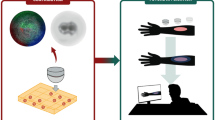Abstract
Edge detection is always an interesting field for researchers in the area of artificial intelligence, including machine visions and robotics. In the context of tactile sensors, many studies have been conducted on edge-identification algorithms. These investigations often use high-resolution tactile sensor arrays to track an edge of a large object. In this work, edge identification is examined in which a coarse-resolution tactile sensor, specif., a 2×2 array, is used to detect and track edges of a small object. To simplify the control, we control the sensor just in 2D and in just one direction at a time. We propose two methods to solve this problem: a scanning method, of which the principle of operation is similar to that of a scanner, and an edge-following method that can make the sensor follow the boundary of the object. The flowchart of each method will be presented in detail in this paper. Some simulations in MATLAB, including four shapes, viz., square, triangle, ellipse, and hexagon, have been executed to verify our proposal. A comparison and a critique of the two methods are also presented for improving the methods.
Similar content being viewed by others
References
Bealey, R. A. and Howe, R. D., “Tactile Tracking of Arteries in Robotic Surgery,” Proceeding of the IEEE International Conference on Robotics and Automation, Vol. 4, pp. 3801–3806, 2002.
Krishna, G. M. and Rajanna, K., “Tactile Sensor Based on Piezoelectric Resonance,” IEEE Sensor Journal, Vol. 4, No. 5, pp. 691–697, 2004.
Tanaka, T., Makihira, K. and Aoyagi, S., “Recognition of Contact State of Arrayed Type Tactile Sensor by using Neural Network,” Proceeding of the 2005 IEEE International Conference on Information Acquisition, pp. 37–42, 2005.
Schopfer, M., Ritter, H. and Heidemann, G., “Acquisition and Application of a Tactile database,” Proceeding of the IEEE International Conference on Robotics and Automation, pp. 1517–1522, 2007.
Okamura, A. M., Turner, M. L. and Cutkosky, M. R., “Haptic Exploration of Objects with Rolling and Sliding,” Proceeding of the 1997 IEEE International Conference on Robotics and Automation, Vol. 3, pp. 2485–2490, 1997.
Chen, N., Zhang, H. and Rink, R., “Edge Tracking Using Tactile Servo,” Proceeding of 1995 IEEE/RSJ International Conference on Intelligent Robotics and System, Vol. 2, pp. 84–89, 1995.
Suwanratchatamanee, K., Matsumoto, M., Saegusa, R. and Hashimoto, S., “A simple tactile sensor system for robot manipulation and object edge shape recognition,” The 33rd Annual Conference of the IEEE Industrial Electronics Society (IECON), pp. 245–250, 2007.
Berger, A. D., “On using a tactile sensor for Realtime Feature Extraction,” Degree of Master of Science, Electrical Engineering, Department of Electrical and Computer Engineering, Carnegie Mellon University, 1998.
Heidemann, G. and Schopfer, M., “Dynamic Tactile sensing for Object Identification,” Proceedings of the 2004 IEEE International Conference on Robotics and Automation, Vol. 1, pp. 813–818, 2004.
Arabshahi, S. A. and Jiang, Z., “Development of a tactile sensor for Braille pattern recognition: sensor design and simulation,” Smart Materials and Structures, Vol. 14, No. 6, pp. 1569–1578, 2005.
Kim, B.-H., “Modeling and Analysis of Robotic Dual Soft-fingered Writing,” Int. J. Precis. Eng. Manuf., Vol. 10, No. 2, pp. 17–23, 2009.
Lee, C.-S., “Tool Path Generation for a Four-axis Machine to Engrave Letters on Tire Sidewall Molds,” Int. J. Precis. Eng. Manuf., Vol. 10, No. 3, pp. 75–82, 2009.
Cho, S. H., “Trajectory Tracking Control of a Pneumatic X-Y Table Using Neural Network Based PID Control,” Int. J. Precis. Eng. Manuf., Vol. 10, No. 5, pp. 37–44, 2009.
Author information
Authors and Affiliations
Corresponding author
Rights and permissions
About this article
Cite this article
Phung, T.C., Ihn, Y.S., Koo, J.C. et al. Edge identification of a small object through a low-resolution tactile sensor array. Int. J. Precis. Eng. Manuf. 11, 247–254 (2010). https://doi.org/10.1007/s12541-010-0028-x
Received:
Accepted:
Published:
Issue Date:
DOI: https://doi.org/10.1007/s12541-010-0028-x




